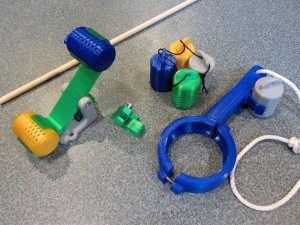MakerBot Announces Winners of 3D Printed Assistive Technology Challenge

by Clare Scott
The design and development of assistive technology is one of the most promising facets of the 3D printing revolution. Easing the lives of people with disabilities has been a priority for a number of companies, schools, and organizations who have sponsored challenges and makeathons geared towards the development of assisitve devices. At the end of September, MakerBot launched an Assistive Technology Challenge that invited Thingiverse users to use the recent Bay Area Makeathon as inspiration to develop their own assistive devices.
The mouse was designed as a mouthpiece with a small joystick attached. The mouthpiece itself was 3D printed, and all other  components, including hardware and electronics, were obtained from local hardware stores and on eBay.
components, including hardware and electronics, were obtained from local hardware stores and on eBay.
Second place went to architect Hugo Riveros, who designed a wheelchair that he named “HU-GO.” Riveros, who is originally from Chile, was visiting home when he was struck by how many people who need wheelchairs are unable to afford them. Basing his design off of his own wheelchair, which he has to use periodically due to a condition called spondylo arthritis, Riveros created a 3D printable version that he designed using ArchiCAD software. (We first covered his design last month, when he was just getting started.) For the parts that couldn’t be 3D printed, Riveros, like Wirtl, used inexpensive, readily available components like plywood, zip ties and even socks and flour sacks for cushioning. His hope is that his design will make its way to third world countries were access to expensive medical technology is unavailable. 
In third place is Jeff Kerr, who designed a kit to help dogs help people. The Assistive Devices for Assistance Dogs starter kit includes several 3D printable items to help assistance dogs better navigate environments designed for people, but which their people cannot navigate alone. The items include a paddle that allows dogs to manipulate light switches, a door knob puller and scent coded training fobs to teach dogs how to better distinguish between multiple targets in cluttered environments.

